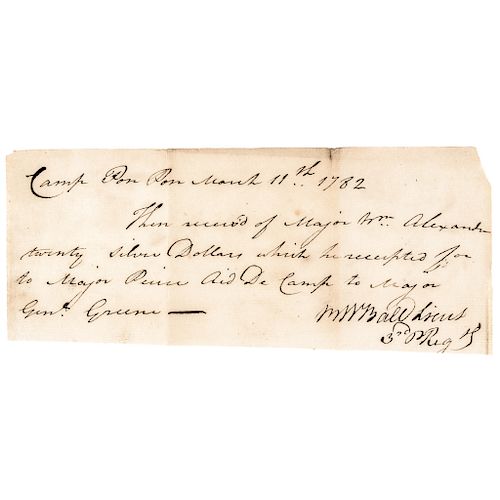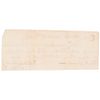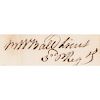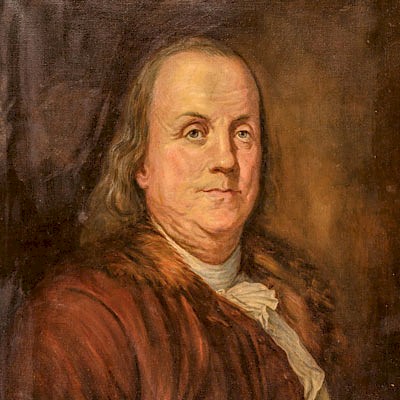1782 Revolutionary War Document Mentions Genl. Greene, Majors Alexander + Pierce
Lot 158
Estimate:
$500 - $600
Absentee vs Live bid
Two ways to bid:
- Leave a max absentee bid and the platform will bid on your behalf up to your maximum bid during the live auction.
- Bid live during the auction and your bids will be submitted real-time to the auctioneer.
Bid Increments
| Price | Bid Increment |
|---|---|
| $0 | $10 |
| $200 | $20 |
| $300 | $25 |
| $500 | $50 |
| $1,000 | $100 |
| $2,000 | $200 |
| $3,000 | $250 |
| $5,000 | $500 |
| $10,000 | $1,000 |
| $20,000 | $2,000 |
| $30,000 | $2,500 |
| $50,000 | $5,000 |
| $100,000 | $10,000 |
| $200,000 | $20,000 |
| $300,000 | $25,000 |
| $500,000 | $50,000 |
About Auction
By Early American History Auctions
Aug 24, 2019
Set Reminder
2019-08-24 12:00:00
2019-08-24 12:00:00
America/New_York
Bidsquare
Bidsquare : Autographs, Colonial Currency, Political Americana, Historic Guns
https://www.bidsquare.com/auctions/early-american-history-auctions/autographs-colonial-currency-political-americana-historic-guns-4347
Historic Autographs • Colonial Currency • American Civil War Colonial Era • Revolutionary War • Political Americana • Black History Early American History Auctions auctions@earlyamerican.com
Historic Autographs • Colonial Currency • American Civil War Colonial Era • Revolutionary War • Political Americana • Black History Early American History Auctions auctions@earlyamerican.com
- Lot Description
American Revolution
1782 Revolutionary War Manuscript Document Mentioning Several Historic Figures Sending "twenty Silver Dollars..."
March 11, 1782-Dated Revolutionary War, Manuscript Document Signed, "M.W. Ball Lieut. 3rd P(ennsylvania) Reg(iment), at Camp Pon Pon (South Carolina), Transmittal Payorder from Major General (Nathanael) Greene (Member Society of the Cincinnati) thru Major William Alexander (Member Society of the Cincinnati), of "twenty Silver Dollars...", Choice Very Fine.
This original Document is dated March 11, 1782, at Camp Pon Pon (near Charleston, South Carolina) where a Lieutenant M. W. Ball of the 3rd Pennsylvania Regiment has received payment from Major William Alexander, which he receipted for from Major (William) Pierce (ca. 1740-1789), Aide De Camp of Major General Nathanael Greene (a.k.a.: "The Savior of the South" or "The Fighting Quaker"). This Payment Document measures 3" x 6", being boldly penned and signed in rich brown ink on very clean laid period paper, mentioning (not signed by) Greene, Alexander or Pierce. This Document reads, in full:
"Camp Pon Pon - March 11th, 1782 --- Then received of Major Wm. Alexander twenty Silver Dollars which he receipted for to Major Pierce Aid(e) De Camp to Major Genl. (Nathanael) Greene -- (Signed) M. W. Ball Lieut. 3rd P(ennsylvania) Reg(iment)."
Nathanael Greene (1742-1786), (sometimes misspelled Nathaniel) was a Major General of the Continental Army in the American Revolutionary War, known for his successful command in the Southern Campaign, forcing British Lieutenant General Charles Cornwallis to abandon the Carolinas and head for Virginia. When the war began, Greene was a militia private, the lowest rank possible; he emerged from the war with a reputation as George Washington's most gifted and dependable officer.
The 3rd Pennsylvania Regiment, first known as the 2nd Pennsylvania Battalion, was raised on December 9, 1775, at Philadelphia, Pennsylvania for service with the Continental Army. The regiment would see action during the Battle of Valcour Island, Battle of Brandywine, Battle of Germantown, Battle of Monmouth and the Battle of Springfield. The regiment was furloughed, on June 11, 1783, at Philadelphia, Pennsylvania and disbanded on November 15, 1783.
In February of 1781, Gen. Anthony Wayne was ordered to the command of a force of about 800 men, to be selected from the six regiments of the Pennsylvania Line, then rendezvousing at York, Penna., destined to reinforce Gen. Greene in South Carolina. Owing to the lack of equipment and sufficient transportation, and the mutiny which broke out and the ringleaders executed, Wayne's force was not able to move until May 26, 1782.
General Greene's army remained at Pon Pon, South Carolina until 22 March when they moved near Stono Church, where Lt. Tilden noted on the 23d, "This being good ground, we expected toremain here some time, therefore began to build chimneys to our tents. Orders in the evening to march at 9 o'clock tomorrow, a great mortification to some of us who went to the trouble to make brick chimneys which we got from Stono Church." (Lieutenant Feltman described the structure he and his tentmates built as, "a very elegant brick chimney.")
On the 24th the Continental troops marched and encamped "one mile from ye Cross Roads and two from Beacon's [Bacon's] bridge." The next day orders for the 1st Pennsylvania (Provisional) Battalion directed, "One officer of a Compy. (at least) will superintend the building the brush Hutts, they will be rais'd in the manner of Tents, in order to establish uniformity, and none to be built in front of the ground laid out for that purpose by the soldiers...".
The activities of 26th March were related by William Feltman: "This day was very busily employed by both officers and soldiers, in building huts, raising tents,cleaning the encampment, &c." A week later General Greene ordered from "Near Bacons bridge... that no boards or planks be taken by any part of the Army for the purpose of building Huts, except such as the Q(uarter) Master shall point out."
With the coming of Spring, General Greene's Southern Army was largely sedentary, their camps moresettled; this state of affairs continued until British forces evacuated Charleston in December 1782.
_____
Major Pierce was an officer in the Revolutionary War (1775-83), a member of the Continental Congress, and a Georgia state legislator. Although traditionally believed to be a native Georgian, William Leigh Pierce was born in York County, Virginia, around 1740, the third and youngest son of Elizabeth and Matthew Pierce. Though frequently referred to with a middle name of "Leigh," he always signed his name as "William Pierce Jr.," perhaps to distinguish himself from an uncle of the same name. Young Pierce studied art for a short time in Maryland under Charles Willson Peale and returned to Williamsburg, Virginia, in the summer of 1775 to practice his new skills. Siding with the patriots at the beginning of the Revolutionary War, Pierce participated in the fighting at Hampton, Virginia, in the autumn of 1775. He was commissioned a captain in the First Continental Regiment of Artillery the following year, and his regiment was ordered to join the main army at Valley Forge, Pennsylvania, in the spring of 1778. Shortly thereafter Captain Pierce's company was detached to Major General John Sullivan's command in Rhode Island.
Nathanael Greene was one of the most respected generals of the Revolutionary War and a talented military strategist. As commander of the Southern Department of the Continental army, his leadership was the catalyst that turned the tide toward American victory in Georgia.
Nathanael Greene from poor health, Pierce resigned his command and accepted a position as an aide-de-camp to General Sullivan in early 1779. He attended his commander in the expedition to upstate New York during the summer to suppress the Iroquois Indians, who remained loyal to the British. Returning to Williamsburg on furlough in early 1780, he studied at the College of William and Mary and became a member of Phi Beta Kappa. Pierce received an invitation in December 1780 to become an aide to Major General Nathanael Greene. He accepted and joined his new corps in early February 1781 on its fighting retreat from the British Army in North Carolina.
During the next two years, Pierce proved himself valuable to his general, not only in his secretarial duties but also as an officer and soldier. He assisted in rallying a contingent of Virginia troops at a critical moment during the Battle of Hobkirk's Hill in South Carolina, for example, and was also Greene's choice to carry news of the Battle of Eutaw Springs, also in South Carolina, to the Continental Congress.
In mid-1783 Pierce and two fellow officers established a business in Savannah, and in December of that year, with the end of the campaign, Pierce married Charlotte Fenwick, the daughter of a wealthy South Carolina planter. The following spring the couple moved to Savannah, where they eventually acquired both a house in town and a confiscated Loyalist plantation, Belmont. The couple had four sons, only one of whom, William Leigh, survived to adulthood. Soon after the move to Savannah, Pierce sold his share of the business to partner Richard Call, and the following year he began a new business under the name William Pierce and Company.
Finding that business was not as profitable as he had hoped, Pierce sought political office and was elected in 1786 to represent Chatham County in the Georgia House of Representatives. That body promptly elected him to the Continental Congress, and he also became a delegate to the Constitutional Convention. In January 1787 he attended the Congress in New York City, followed in May by the convention in Philadelphia, Pennsylvania. At the proceedings he spoke on a number of points but also recorded a series of "Character Sketches," which provides a contemporary narrative on the personalities of the convention members.
Although he agreed with the end result of the proceedings, Pierce did not sign the U.S. Constitution, having left the convention at the end of June to attend to "a piece of business so necessary that it became unavoidable." The business was a duel with merchant John Auldjo, after tempers flared over mishandled "mercantile dealings." Auldjo's second, Alexander Hamilton, intervened and prevented the contest. Returning to Georgia, Pierce continued to serve in the state legislature, and in 1789 he received a respectable number of votes for governor. He died at his plantation on December 10, 1789, after a lingering illness.
- Shipping Info
-
Early American provides in-house worldwide shipping. Please contact us directly if you have questions about your specific shipping requirements.
-
- Buyer's Premium



 EUR
EUR CAD
CAD AUD
AUD GBP
GBP MXN
MXN HKD
HKD CNY
CNY MYR
MYR SEK
SEK SGD
SGD CHF
CHF THB
THB













